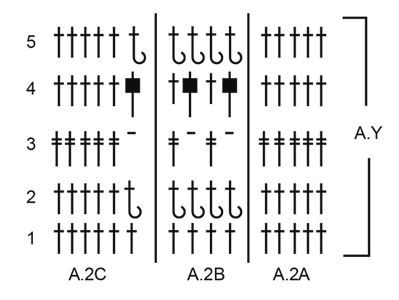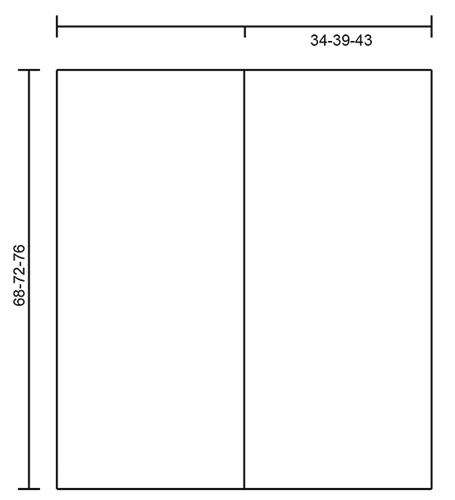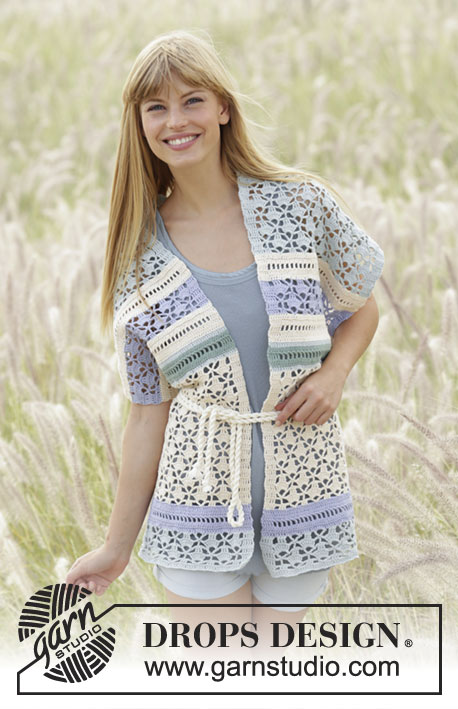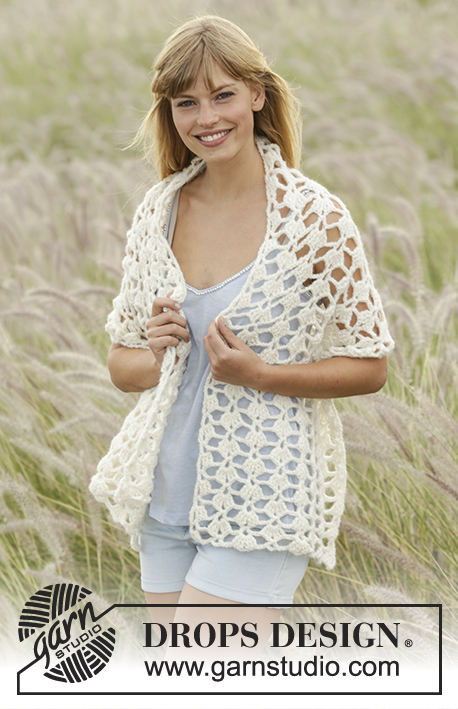Spring Lullaby |
|||||||||||||||||||||||||||||||
|
|
|||||||||||||||||||||||||||||||
Crochet DROPS vest with lace pattern edge in stripes with ties in waist in ”Safran”. Size S-XXXL.
DROPS Extra 0-1296 |
|||||||||||||||||||||||||||||||
|
PATTERN: See diagrams A.1 and A.2. CROCHET INFO: Replace first dc at beg of every dc row with 3 ch. Finish row with 1 dc in 3rd ch from beg of previous row (if previous row was a dc row) and with 1 dc in 4th ch from beg of previous row (if previous row was a tr row). Replace first tr at beg of every tr row with 4 ch. Finish row with 1 tr in 3rd or 4th ch from beg of previous row as explained above. LACE PATTERN (see diagram A.1): ROW 1 (= RS): 3 ch (= 1 dc), 1 dc in each of the next 4 dc, ch 2, skip 2 dc, 1 dc in each of the next 3 dc, * ch 2, skip 3 dc, in next dc work 1 tr + 4 ch + 1 tr, ch 2, skip 3 dc, 1 dc in each of the next 3 dc *, repeat from *-* until 5 dc remain on row, work 2 ch and finish with 1 dc in each of the last 5 dc, turn piece. ROW 2: 4 ch (= 1 tr), 1 tr in each of the next 4 sts, ch 2, * 1 tr in the middle of the 3 sts from previous row, ch 2, 7 tr around ch-space between tr, 2 ch *, repeat from *-* 6-7-8 times in total, work 1 tr in the middle of the next 3 sts, 2 ch and 1 tr in each of the last 5 sts on row, turn piece. ROW 3: 4 ch (= 1 tr), 1 tr in each of the next 4 tr, in next tr work 1 tr + 4 ch + 1 tr, * ch 2, 1 tr in each of the middle 3 tr in group, ch 2, skip 2 tr, in next tr work 1 tr + 4 ch + 1 tr *, repeat from *-* 6-7-8 times in total and finish with 1 tr in each of the last 5 tr, turn piece. ROW 4: 4 ch (= 1 tr), 1 tr in each of the next 4 tr, ch 2, * 7 tr around ch-space between tr, ch 2, 1 tr in the middle of the 3 tr in group, 2 ch *, repeat from *-* 6-7-8 times in total, 7 tr around ch-space between tr, 2 ch and 1 tr in each of the last 5 tr, turn piece. ROW 5: 4 ch (= 1 tr), 1 tr in each of the next 4 tr, ch 2, 1 tr in each of the middle 3 tr in group, ch 2, skip 2 tr, * in next tr work 1 tr + 4 ch + 1 tr, ch 2, 1 tr in each of the middle 3 tr in group, ch 2, skip 2 tr *, repeat from *-* 6-7-8 times in total and finish with 1 tr in each of the last 5 tr, turn piece. Repeat 2nd-5th row (= A.X). STRIPE WITH EYELET ROW (see diagram A.2): ROW 1: 3 ch (= 1 dc), 1 dc in each of the next 4 sts, then work 1 dc in every tr from previous row, 3 dc around every ch-space with 4 ch and 1 dc around every ch-space with ch 2, finish with 1 dc in each of the last 5 tr = 75-85-95 dc, turn piece. ROW 2: 3 ch (= 1 dc), 1 dc in each of the next 4 sts, then work 1 dc in every dc until 5 dc remain on row, but work in back loop of st from RS and front loop of st from WS, finish with 1 dc in each of the last 5 sts (now work through both loops), turn piece. ROW 3: 4 ch (= 1 tr), 1 tr in each of the next 4 sts, * ch 1, skip 1 st, 1 tr in next st *, repeat from *-* until 6 sts remain on row, ch 1, skip 1 st and finish with 1 tr in each of the last 5 sts on row, turn piece. ROW 4: 3 ch (= 1 dc), 1 dc in each of the next 4 sts, then work 1 dc around every ch and 1 dc in every st the entire row, turn piece = 75-85-95 dc on row. ROW 5: 3 ch (= 1 dc), 1 dc in each of the next 4 sts, then work 1 dc in every dc until 6 dc remain on row, but work in back loop of st from RS and front loop of st from WS, work 1 dc more in back/front loop and finish with 1 dc in each of the last 5 sts (now work through both loops), turn piece. ---------------------------------------------------------- VEST: Work 4 equal parts and work from bottom up. Work 2 and 2 parts tog in the middle (short side against short side) to make 2 long scarves. Then work the 2 scarves tog alongside mid back. PART 1: Work 101-114-127 loose ch on hook size 3.5 mm/E/4 with ice blue. Work first row as follows from WS: 1 dc in 4th ch from hook, 1 dc in each of the next 1-2-3 ch, * skip ch 1, 1 dc in each of the next 3 ch *, repeat from *-* the entire row = 75-85-95 dc. READ CROCHET INFO! Then work LACE PATTERN - see explanation above, i.e. work pattern according to diagram A.1 as follows: Work A.1A (= 10 sts), repeat A.1B over the next 60-70-80 sts and finish with A.1C (= 5 sts). REMEMBER THE CROCHET GAUGE! When A.X has been worked 1 time vertically, switch to light blue purple. Work STRIPES WITH EYELET ROW – see explanation above, i.e. work according to diagram A.2 as follows: Work A.2A (= 5 sts), work A.2B until 5 sts remain on row and finish with A.2C (= 5 sts) = 75-85-95 sts on row – NOTE: To get the correct number of sts work as follows on 1st row: Work 10 dc over A.1A, i.e. 1 dc in each of the 5 edge sts, 1 dc around ch-space, 1 dc in each of the middle 3 sts and 1 dc around ch-space. Then work 10 dc over every repetition in A.1B, i.e. 1 dc in first tr, 3 dc around ch-space, 1 dc in next tr, 1 dc around ch-space, 1 dc in each of the middle 3 dc in group and 1 dc around ch-space (= 60-70-80 dc in total over A.1B), then work 5 dc over A.1C, i.e. 1 dc in each of the 5 edge sts = 75-85-95 dc on row. Continue according to diagram A.2 until A.Y has been worked 1 time vertically. Switch to off white and work 1st-5th row in A.1 (1st row in A.1 work over A.2 as shown in diagram A.1), then repeat 2nd-5th row (= A.X) until lace pattern with off white measures approx. 25 cm / 9 3/4'' – finish after one whole or half repetition in A.X. Switch to ice blue and work 1st row in A.2, switch to green and work 2nd-4th row in A.2, switch to ice blue and work 5th row in A.2, switch to off white and work 1st-5th row in A.2 (= A.Y). Switch to light blue purple and work 1st-5th row in A.1, switch to off white and work 1st-5th row in A.2 and switch to ice blue and work 1st-5th row in A.1, then repeat 2nd-5th row (= A.X) until piece measures approx. 67-71-75 cm / 26½"-28"-29½"– finish after one whole or half repetition in A.X. Work 1st row in A.2 with ice blue = 75-85-95 dc on row. Fasten off, piece now measures approx. 68-72-76 cm / 26 3/4"-28½"-30". Work 3 more parts the same way. Work 2 and 2 parts tog in the middle with ice blue as follows: Place WS against WS (short side against short side) and work through both layers with 1 sc in every st (crochet tog = mid on top of shoulder). Fasten off. There are now 2 equally long scarves. Place the 2 scarves against each other, long side against long side. Beg in one end of the 2 scarves and sew them tog alongside (= mid back) – sew with neat little stitches until approx. 8-10-12 cm / 3"-4"-4 3/4" before shoulder. Fasten off. Vest is open from mid back of neck and the entire way down along mid front. TWINED STRING: Cut 3 lengths off white yarn of 5 metres/5.25 yds each. Twine the strands tog until they resist, fold the string double so that it twines again. Tie a knot in each end and shape the ends by cutting. Use tie as a belt. |
|||||||||||||||||||||||||||||||
Diagram explanations |
|||||||||||||||||||||||||||||||
|
|||||||||||||||||||||||||||||||

|
|||||||||||||||||||||||||||||||

|
|||||||||||||||||||||||||||||||

|
|||||||||||||||||||||||||||||||
|
Have you made this or any other of our designs? Tag your pictures in social media with #dropsdesign so we can see them! Do you need help with this pattern?You'll find tutorial videos, a Comments/Questions area and more by visiting the pattern on garnstudio.com. © 1982-2024 DROPS Design A/S. We reserve all rights. This document, including all its sub-sections, has copyrights. Read more about what you can do with our patterns at the bottom of each pattern on our site. |
|||||||||||||||||||||||||||||||

















































Comments / Questions (9)
Bjr tte débutante. il me semble que je dois crocheter le diagramme en commençant par A.1a, A1b,A1c puis remonter jusqu'au rang 5,et le recommencer jusqu'à la fin du rang. et je ne comprends pas, il me semble que les explications du point fantaisie sont différentes du diagramme. Dans l'attente de votre retour. belle journée nathalie
26.02.2024 - 10:56DROPS Design answered:
Bonjour Nathalie, lorsque les 5 rangs (= A.X) ont été faits, vous changez de couleur et crochetez maintenant une rayure en bleu violet clair en suivant cette fois les diagrammes A.2A, A.2B et A.2C. Quand A.Y est terminé, crochetez les rangs 1-5 en naturel, puis répétez les rangs 2-5 jusqu'à ce que la rayure en naturel mesure 25 cm. Bon crochet!
26.02.2024 - 13:48Hello, is this pattern has stitches along the sides. Otherwise how will this vest will be in place around the body?
13.07.2022 - 16:10DROPS Design answered:
Dear Srijani, yes, this pattern has stitches along the sides. When working the right front, the side is included in A.1A; when working the left front, the other side is included in A.1C. Happy crocheting!
15.07.2022 - 12:51Hello, I want to know is this pattern have stitches along the sides...otherwise how will this pattern be in place around the body?
13.07.2022 - 16:09DROPS Design answered:
Dear Mrs Chakraborty, there is no seam along the sides, the jacket is closed with the string as a belt. Feel free to sew or crochet the sides together if you rather like it so. Happy crocheting!
02.08.2022 - 11:40Dank voor uw antwoord. Ik denk dat ik toch een andere oplossing kies. Ik haak een extra toer stokjes in naturel tussen de twee gaatjespatronen, dus direct na de toer in ijsblauw. Dat vind ik mooier dan de draad afknippen. Dan kom ik wel aan de goede kant uit met de volgende gaatjes en met het kantpatroon. Ik ben inmiddels met drie van de vier op de hoogte van 25 cm, dus kan nu mooi door.
03.03.2022 - 22:28Dank voor uw uitleg. Dit klopt voor het onderste deel. Maar in het bovenste deel kom ik er niet goed uit. Ik bedoel na 25 cm naturel. Dan haak je 10 toeren gaatjespatroon en kom je aan de andere kant uit en zitten de waaiers er boven verkeerd om. Ik heb nog gekeken op de foto of er een extra toer stokjes tussen de 2 gaatjespatronen zit, maar dat lijkt niet zo. Hoe kom ik dan toch aan de goede kant met de waaiers boven de 2 gaatjespatronen?
11.02.2022 - 22:41DROPS Design answered:
Dag Gea,
Excuses voor het late antwoord. Volgens mij is het inderdaad wel zo dat je laatste keer dat je A.1 haakt, dus in ijsblauw, niet goed uit komt. Dit moet nog even nagekeken worden door de ontwerpafdeling. Je zou de draad af kunnen knippen en aan de goede kant kunnen beginnen. Hopelijk kun je zo eerst verder.
02.03.2022 - 13:47Ik kom er niet goed uit met de goede en verkeerde kant. Als ik in het onderste, ecru deel de waaiers van 7 dstk aan de goede kant maak, kom ik na de strepen er op uit dat de waaiers in paarsblauw aan de verkeerde kant zitten. Is dat de bedoeling? Of sla ik ergens per abuis een toer over? Of moet ik juist het onderste deel omdraaien, zodat die waaiers daar aan de verkeerde kant zitten en dan de paarsblauwe waaiers aan de goede kant?
08.02.2022 - 01:15DROPS Design answered:
Dag Gea,
Als je (na de waaiers aan de goede kant) strepen begint te haken, haak je dus 5 toeren van strepen, waarbij de eerste en de laatste toer aan de verkeerde kant is. Hierdoor begin je weer met patroon A.1 aan de goede kant en zou je weer goed uit moeten komen. Let er op dat je dan de toer met de ster ervoor in A.1 niet haakt.
11.02.2022 - 15:33Hej Drops ;) Tænker om 404 masker ikke er voldsomt meget, har haft den startet og den blev meget stor. Hilsen Bente
06.06.2020 - 09:53Moeten er geen zijnaden gemaakt worden? Anders zijn het toch losse lappen en dat vind ik heel raar.
19.07.2018 - 18:22Bonjour, j'aimerais faire la cordelette. Pouvez-vous me dire combien elle mesure une fois enroulée? Je voudrais ce genre de ceinture pour mettre autour d'un pull que j'ai tricoté. Merci.
22.05.2018 - 07:15DROPS Design answered:
Bonjour Sonia, la longueur de la cordelière va dépendre de la façon dont vous avez serré le fil, et même le fil peut jouer. Vous pouvez vous baser sur un modèle similaire et faire éventuellement un échantillon-test de cordelière pour calculer la longueur dont vous avez besoin pour la ceinture. Bon tricot!
22.05.2018 - 12:51